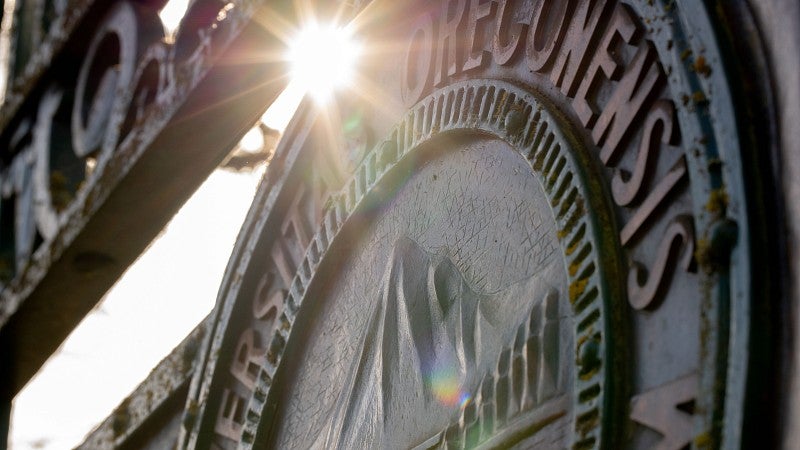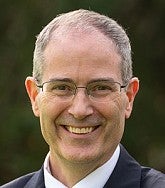
UO launches a new strategic plan with Oregon Rising
The university will strengthen service to students, state and nation with four goals rooted in feedback and supported by a clear plan for action
As a student member of the University of Oregon Board of Trustees, senior Ruby Wool has one foot in the world of UO leadership and one in the world of students. From where she stands, the UO’s new strategic goals place the institution on solid ground.

At this time last year, the UO was engaged in a massive effort to garner advice on the goals from the entire university community — faculty members, staff, students, alumni, administrators and other stakeholders. Wool tasked herself with gauging student concerns; through meetings, student government activities, impromptu conversations and even just strolls across the Eugene campus, she heard from her peers a need to feel a sense of belonging, to graduate without substantial debt, to get a job.
All three are reflected in the goals being unveiled in the Strategic Plan.
“For things like graduating on time, finishing in four, those are goals that students want to achieve because going to college can be a big financial burden,” Wool said. “I am encouraged because you see [student needs] reflected in our strategic plan. The goals encompass a lot.”
A framework for our aspirations
The strategic goals that will guide the UO for the next decade are rooted in feedback from across the university.

“Oregon Rising is a framework that defines our goals, strategies and measures of success,” said President Karl Scholz. “It reflects both our aspirations and the principles we will employ to achieve them.
“I am proud that this plan was developed through an iterative and inclusive process that benefitted from the input, ideas, participation and contributions of people across all areas of the university — from students, staff, faculty, alumni, civic and government leaders, and others. We are now committed — and university leadership is committed — to doing the work to achieve those goals.”
Oregon Rising includes four strategic goals: 1) enhance pathways to timely graduation, 2) become a leader in career preparation, 3) create a flourishing community and 4) accelerate the UO’s impact on the world.
An inclusive process
The UO Onward planning team facilitated 25 in-person and Zoom input sessions. Some 1,200 participated through sessions and a survey. Scholz gave dozens of speeches and urged participation at community talks, meet-and-greets, faculty welcomes, staff retreats, and events for students and alumni. More than 3,000 comments were shared with leaders, who continue to consider them as work begins on the goals.

“There was an opportunity for everyone to participate,” said Judy Kanavle, a member of the strategic plan implementation team and director of program and project management in the Office of the Provost. “We really tried to get as much input as possible from a diverse group of constituents, stakeholders and other members of the community.”
For example, a goal to “improve four-year and six-year graduation rates” was modified because feedback pointed out the need to address underlying causes that affect students’ ability to move toward degree completion. Leaders subsequently revised the priority to be, “enhance pathways to timely graduation” and — recognizing that cost is a factor for students — added a strategy around financial aid
Last winter, teams of a dozen people for each goal developed potential strategies, tactics and key performance indicators for achieving them. University leaders evaluated the ideas, and then adopted about five strategies for every goal.
To help drive success in timely graduation rates, for instance, one strategy will be to provide “effective, targeted financial assistance to students.” In pursuit of creating a flourishing university, strategies include furthering efforts to recruit and retain a diverse faculty and staff, and to strengthen infrastructure to meet the needs of an evolving student population.
The plan’s fourth goal is defined by four signature areas of scholarship the university will focus on: environmental resilience, youth behavioral and mental health, human performance and sport, and accelerating innovation and scientific impact.
With the completion of the UO Onward engagement process, the university now begins the work of achieving the four strategic goals under a new phase: Oregon Rising.
Our shared principles
How the university moves forward to achieve the four goals is also important. As a result of comments gathered during the engagement period, the university has adopted seven principles for pursuing the strategic goals
- Prioritize work toward common goals
- Break down silos and align efforts
- Acknowledge human and financial resources
- Make data-informed decisions
- Create accountability
- Embed an equity-minded approach
- Celebrate and share successes

“Principles offer us specific ways to put our values into practice,” said Christopher P. Long, provost and senior vice president. “If each of us remains mindful of these principles as we pursue the goals of the Oregon Rising plan, our work together will enhance the student experience and elevate the academic life of the university.
Ron Bramhall, associate vice provost for academic affairs, chaired the team that made recommendations for how to achieve the timely graduation goal. He’s optimistic about the goals because of the expectations that have been built into them.
For example, a policy and practice action team will be empowered to assess barriers to timely graduation university-wide and determine how to remove them. Bramhall noted, too, that the focus on accountability through things like performance reviews will be key to meeting the goals.
“When it gets into that place,” he said, “then it gets real.”
The university’s vice presidents, deans, vice provosts and other leaders have two priorities for this academic year: to socialize the plan and align work across the university to track with the new goals and strategies; and to create and implement the operational structures the university needs to make progress toward strategy-specific milestones.
Jamie Bufalino, associate dean for undergraduate education in the College of Arts and Sciences, said two areas will be critical in the next phase: communication and data-driven decisions. As a member of the team that analyzed the career-preparation goal, Bufalino said its success will hinge on reaching all students, regardless of their circumstances, about career-development opportunities and “having data that allows us to be able to know how we’re doing” in placing them into jobs.
Long noted that the university will create an opportunity for advice, reflection and learning along the way; will adjust the goals and strategies as necessary based on what is learned; and will develop an annual implementation plan that integrates feedback.

Ongoing feedback will be important for success, according to Jina Kim, an associate professor in East Asian languages and literatures who served on the timely graduation team. She said incorporating more faculty voices will help ensure, for example, that changes to curriculum to remove barriers to timely graduation don’t come at the expense of courses that give students the knowledge they need for mastery.
“The strategies for the goals aren’t set in stone,” Kim said. “They can be modified and there are many opportunities for faculty to contribute to this process.”
A time of breathtaking opportunity
The strategic plan will put the University of Oregon in a stronger position to fulfill its mission in support of students, the state of Oregon and the nation. The university now begins the work of achieving four goals under a new phase: Oregon Rising.

